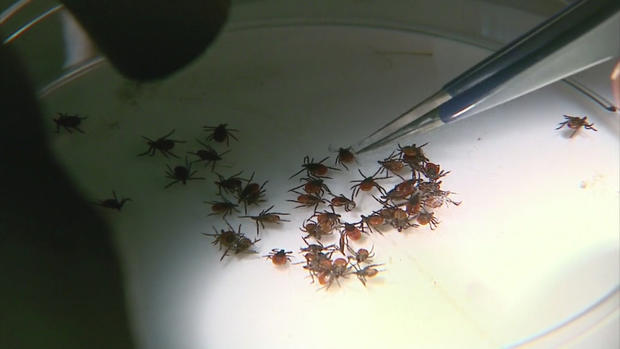New Study Provides Medical Professionals Valuable Information On Types Of Ticks In Suffolk County
YAPHANK, N.Y. (CBSNewYork) -- The results are in for a three-year study of ticks in Suffolk County.
It found a wide array of diseases that the arachnids carry, not just Lyme disease, CBS2's Carolyn Gusoff reported Wednesday.
Glenn Andreiev of Kings Park doesn't remember getting bitten, but his symptoms were unmistakable.
"No appetite. You couldn't taste food. I was just getting weaker and weaker," Andreiev said.
Andreiev was rushed to the hospital, where staff recognized a tick-borne illness. But it wasn't Lyme disease.
MORE: Tips To Avoid Lyme Disease Amid Highest Outbreak In 2 Decades
"Babesiosis. It's very close to malaria. It's nick-named, 'Long Island malaria,'" Andreiev said.
It's a lesser-known disease carried by local ticks. It was found by researchers in a Suffolk Cunty lab. For three years researchers collected thousands of ticks across the county, identifying what diseases they cause. And while Lyme is the most prominent, with some 600 cases per year, they found eight diseases caused by three different types of ticks.
"These agents will cause human disease and the prevention is the same -- you just prevent tick bites. Whether it's a black-legged tick or a Lone Star tick or an American dog tick," said Dr. Scott Campbell, director of the Suffolk County Department of Health's Arthropod-Borne Disease Laboratory.
MORE: Backyard Chickens Eat Harmful Ticks, But Are Giving People Salmonella
The study also tracked ticks by location, so now residents and their doctors can see online which ticks and pathogens are most prevalent in their area to determine what to test for in the event of a bite.
Health Commissioner Dr. James Tomarken said the results are reassuring, consistent with the rest of the state, but the diseases can be serious.
"They all have very similar symptoms -- fatigue, malaise, low-grade fevers, just feeling unwell, maybe a rash," Tomarken said. "They are debilitating. Some may turn out to be chronic."
The study also found not every tick carries disease. The percentage carrying infection varies by location.
"Some pathogens, it was zero. Other pathogens, it was 60-plus percent," Campbell said.
MORE: Experts: When Checking For Ticks Don't Discount Short-Grass Sports Fields
Here are several ways to safeguard against all tick bites:
* Wear light-colored clothing
* Use repellents
* Walk along the center of wooded trails
* Check clothing
* Carefully inspect your body for ticks
The study is not over. It will be continued annually, with thousands of ticks collected and evaluated in 10 locations.
Ticks remain active in weather above 40 degrees, so you should take precautions year round.




